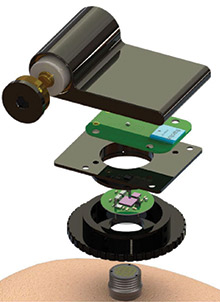
The sensor can transmit data up to 200 megabits a second.
Image courtesy of the Arto Nurmikko lab/Brown University.
In the journal Neuron, scientists in a collaboration led by Brown University describe a high-data, low-power wireless brain-sensing system to acquire high-fidelity neural data during animal behavior experiments. The results show that the technology transmitted rich, neuroscientifically meaningful signals from animal models as they slept and woke or exercised. The sensor system has implications for the wireless control of prosthetic limbs and exoskeletons.
The system is composed of a 100-channel transmitter only 5cm in its largest dimension and weighing 46.1g, and a four-antenna receiver that looks like a home Wi-Fi router. The transmitter connects to a tiny implanted electrode array via a small port embedded in a subject’s skull. The array detects neuron activity in the cortex. The transmitter has been shown to run continuously for more than 48 hours on a single rechargeable AA battery.
In one experiment, three rhesus macaques walked on a treadmill while the researchers used the wireless system to measure neural signals associated with the brain’s motion commands and used other sensors to measure the activity of leg muscles. “In this study, we were able to observe motor cortical dynamics during locomotion, yielding insight into how the brain computes output commands sent to the legs to control walking,” said study co-lead author David A. Borton, PhD, an assistant professor of engineering at Brown.
In another experiment, researchers used the technology to observe brain signals as the animal subjects went through sleep/wake cycles, unencumbered by cables or wires. Again the data showed distinct patterns related to the different stages of consciousness and the transitions between them.
“We hope that the wireless neurosensor will change the canonical paradigm of neuroscience research, enabling scientists to explore the nervous system within its natural context and without the use of tethering cables,” Borton said.
Editor’s note: This story was adapted from materials provided by Brown University.




